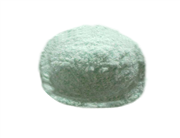| Uses | It can be applied to the fields of pyrotechnics, pesticides, pigments, feed, fungicides, preservatives and other industries for the manufacturing of copper compounds.
It can be applied to analysis reagents and pesticides
It can be applied to organic catalysts, pyrotechnics and pigments. In the field of agriculture, it can be used for the prevention of plants smut, as the poisoning antidote for insecticides and phosphorus poison antidote as well as the germicide of the seeds; being mixed with asphalt can prevent animal husbandry and wild rat from eating seedlings; it can be applied to feed as the copper additive. In the crude oil storage, it can be used as alkali agent and the raw material for the production of copper compounds. It can also be used for electroplating, corrosion and analysis reagents.
It can be applied to paint color, pyrotechnics, pesticides, seed treatment germicide and for preparation of other copper salts. It can also be used as solid fluorescent powder activator. |
| Production method | Copper sulfate method; formulate the baking soda into solution of relative density of 1.05, first add to the reactor, at 50 ° C, under stirring, add refined copper sulfate solution and control the reaction temperature of 70~80 ° C. The reaction takes the change of the precipitate color to peacock green as the turning point with the pH being maintained at 8. After the stopping of the reaction, after standing and sedimentation, use 70~80 ℃ water or no ion-water to wash to until the lotion has no SO42-anymore, followed by centrifugal separation, drying to obtain the finished product of cupric carbonate base. The reaction is:
2CuSO4 + 4NaHCO3 → CuCO3 • Cu (OH) 2 + 2Na2SO4 + 3CO2 ↑ + H2O
Copper nitrate: after the electrolytic copper is reacted with concentrated nitric acid to produce copper nitrate, and then have reaction with the mixture solution of sodium carbonate and sodium bicarbonate to generate cupric carbonate basic. The precipitate is subjecting to washing, separation and dehydration, drying to yield the final products. The reaction processes are:
Cu + 4HNO3 → Cu (NO3) 2 + 2NO2 ↑ + 2H2O
2Cu (NO3) 2 + 2Na2CO3 + H2O → CuCO3 • Cu (OH) 2 + 4NaNO3 + CO2 ↑
2Cu (NO3) 2 + 4NaHCO3 → CuCO3 • Cu (OH) 2 + 4NaNO3 + 3CO2 ↑ + H2O |
| Category | Pesticides |
| Toxic grading | poisoning |
| Acute Toxicity | Oral-Rat LD50: 1350 mg/kg |
| Flammability and hazardous properties | it is non-combustible with combustion yielding toxic copper-containing fumes; |
| Storage and transport characteristics | Treasury at low temperature, ventilation, dry |
| Fire extinguishing agent | water, carbon dioxide, dry powder, and sand |
| Professional Standard | TWA 1 mg/m3; STEL 3 mg/m3 |
| Chemical Properties | Copper carbonate (basic), dark green monoclinic crystals, insoluble in cold H20, decomposes in H20, soluble in potassium cyanide. Malachite, copper ore, is of this composition. Refmed compound is used as a pigment. |
| Chemical Properties | Copper Carbonate (Basic), CuCO3·Cu(OH)2, darkgreen monoclinic crystals, insoluble in cold H2O decomposes in hot H2O, soluble in potassium cyanide. Malachite, a copper ore, is of this composition. Refined compound is used as a pigment. |
| Physical properties | Natural malachite is a dark green crystalline solid; monoclinic crystals; density 4.0 g/cm3; refractive index 1.655; decomposes at 200°C; insoluble in cold water and alcohols; decomposes in hot water; soluble in acids, ammonium hydroxide and potassium cyanide solutions. Natural azurite is blue monoclinic crystal; density 3.88 g/cm3shiz; refractive index 1.730; decomposes at 220°C; insoluble in cold water; decomposes in hot water; soluble in ammonium hydroxide and hot sodium bicarbonate solutions. |
| Uses | Copper(II) carbonate dihydroxide is used as pigments and in treatment for copper deficiency in ruminants. It is also used in pyrotechnics, in sweetening of petrol sour crude stock and animal and poultry feeds. It finds application in some types of make-up such as lipstick. In analytical chemistry, it is used as a reagent for analysis. |
| Uses | Used to kill algae and as a pigment |
| Uses | As seed treatment fungicide; in pyrotechnics; as paint and varnish pigment; in animal and poultry feeds; in sweetening of petrol sour crude stock; in manufacture of other Cu salts. |
| Preparation | Basic carbonate is obtained from its naturally occurring minerals. It also may be prepared by mixing a solution of copper sulfate with sodium carbonate. The precipitate is then filtered and dried. |
| General Description | Copper(II) carbonate basic is naturally found in azurite and malachite. On heating, it undergoes decomposition to form copper(II) oxide, carbon dioxide and water. Due to its high initial discharge capacity, copper(II) carbonate (basic) is being considered as a promising candidate as anode materials for lithium-ion batteries. |
| Hazard | Toxic by ingestion. |









 China
China

 Company information
Company information Advantage
Advantage


